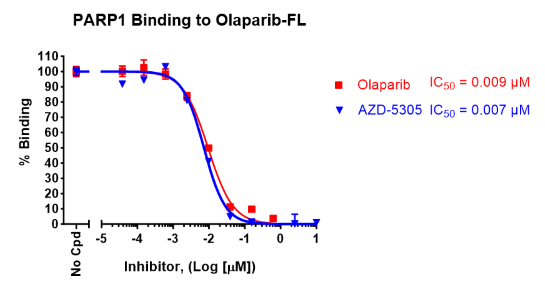
Fluorescence polarization principle applied in FP assay kits.
PARP1 Olaparib Competitive Inhibitor Assay Kit
82293
Product group Assays
Overview
- SupplierBPS Bioscience
- Product NamePARP1 Olaparib Competitive Inhibitor Assay Kit
- Delivery Days Customer7
- CertificationResearch Use Only
- Scientific DescriptionThe PARP1 Olaparib Competitive Inhibitor Assay Kit is a competitive FP (fluorescent polarization) assay designed to measure the formation of a complex between PARP1 (poly(ADP-ribose) polymerase 1) and a fluorescent probe that contains the PARP1 inhibitor Olaparib. When the probe is bound to PARP1, FP is high. In the presence of a test compound able to bind to the same site in PARP1 as Olaparib, the Olaparib-containing fluorescent probe is displaced from PARP1 and remains in solution, resulting in low FP. The PARP1 Olaparib Competitive Inhibitor Assay Kit comes in a convenient 96-well format, with purified PARP1 enzyme, Olaparib-containing fluorescent-labeled probe, and assay buffer for 100 enzyme reactions. Note: This kit is not appropriate for inhibitors expected to bind to PARP1 at different sites from Olaparib. PARP1 binds to the Olaparib-containing fluorescent probe, forming a complex. This complex, when subjected to polarized excitation light, emits highly polarized light due to its restricted movement in solution. In the presence of a test compound (A), PARP1 may form a complex with either the test compound, if the compound has the same binding site of PARP1 as Olaparib, or with the Olaparib-containing fluorescent probe. If the test compound binds to PARP1 at the same site, the Olaparib-containing fluorescent is freed and a decrease in FP is observed. The decrease in FP value is proportional to the competitive binding of the test compound to PARP1. This assay requires a fluorescent microplate reader capable of measuring fluorescence polarization (FP) to read the FP signal. For more information FP technology, visit our Tech Note: FP, assay principles and applications.
- Storage InstructionSee manual
- UNSPSC41116133







